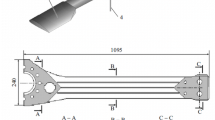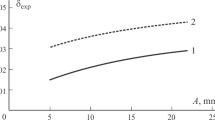A hardware and software system for studying the damping and elastic properties of soft materials in a low-frequency range of deformation up to 100 Hz, which most fully corresponds to the range of dynamic actions in actual service conditions of structures, is proposed. A novel identification method for evaluating the elastic and damping properties of soft materials in shear is developed. It employs the frequency and amplitude characteristics of the resonance flexural vibrations of three-layer test specimens with a soft inner layer. Identification of the elastic shear properties is based on a comparison of calculated and experimental frequencies of resonance vibrations of test specimens. To evaluate the shear damping properties of soft materials, the condition of minimum of an objective function containing experimental and calculated amplitudes of vibrations of the free end of a test specimen is used. The possibility of evaluating the properties mentioned from the experimental and calculated internal damping parameters of test specimens, which significantly reduces the laboriousness of the problem considered, is shown. Numerical calculations are carried out for identifying the elastic and damping characteristics of a technical rubber in shear based on an analysis of resonance flexural vibrations of seven test specimens with outer layers made of a D16AT aluminum alloy.







Similar content being viewed by others
References
V. N. Paimushin and V. M. Shishkin, “Modeling the elastic and damping properties the multilayered torsion bar-blade structure of rotors of light helicopters of the new generation. 1. Finite-element approximation of the torsion bar,” Mech. Compos. Mater., 51, No. 5, 609-628 (2015).
V. N. Paimushin, V. A. Firsov, I. Gyunal, and V. M. Shishkin, “Identification of the elastic and damping characteristics of soft materials based on the analysis of damped flexural vibrations of test specimens,” Mech. Compos. Mater., 52, No. 4, 435-454 (2016).
ASTM E-756, 2004. Standard test method for measuring vibration damping properties of materials. American Society for Testing and Materials.
V. N. Paimushin, V. A. Firsov, I. Gyunal, and A. G. Egorov, “Theoretical-experimental method for determining the parameters of damping based on the study of damped flexural vibrations of test specimens. 1. Experimental basis,” Mech. Compos. Mater., 50, No. 2., 127-136 (2014).
V. N. Paimushin, V. A. Firsov, I. Gyunal, A. G. Egorov, and R. A. Kayumov, “Theoretical-experimental method for determining the parameters of damping based on the study of damped flexural vibrations of test specimens. 3. Identification of the characteristics of internal damping,” Mech. Compos. Mater., 50, No. 5, 633-646 (2014).
A. M. Kamalutdinov and A. G. Egorov. “Determination of the coefficient of aerodynamic drag of a harmoniously vibrating thin plate,” XI All-Russian congress on the fundamental problems of theoretical and applied mechanics, Report Collection, August, 20-24, Kazan, 1693-1695 (2015).
T. Shoup, A Practical Guide to Computer Methods for Engineers, Prentice Hall (1979).
J. L. Ketkov, A. J. Ketkov, and M. M. Schultz, MATLAB 6.x: Programming of Numerical Methods, BXV-Peterburg, Sant-Peterburg (2004).
R. Clough and J. Penzien, Dynamics of Structures, Van Nostrand Reinhold Company, Inc., New York (1985).
V. V. Khilchevskii and V. G. Dubenets, Energy Dissipation at Vibrations of Thin-Walled Structural Members, Vischa Shkola, Kiev (1977).
A. Hashif, D. Jones, and J. Henderson, Vibration Damping, Wiley−Interscience (1985).
Acknowledgements
This research was performed with the support of a grant of the Russian Scientific Fund (Project No. 14-19-00667).
Author information
Authors and Affiliations
Corresponding author
Additional information
Translated from Mekhanika Kompozitnykh Materialov, Vol. 52, No. 5, pp. 813-830, September-October, 2016.
Rights and permissions
About this article
Cite this article
Paimushin, V.N., Firsov, V.A., Gyunal, I. et al. Theoretical-Experimental Method for Evaluating the Elastic and Damping Characteristics of Soft Materials Based on Studying the Resonance Flexural Vibrations of Test Specimens. Mech Compos Mater 52, 571–582 (2016). https://doi.org/10.1007/s11029-016-9608-x
Received:
Published:
Issue Date:
DOI: https://doi.org/10.1007/s11029-016-9608-x




